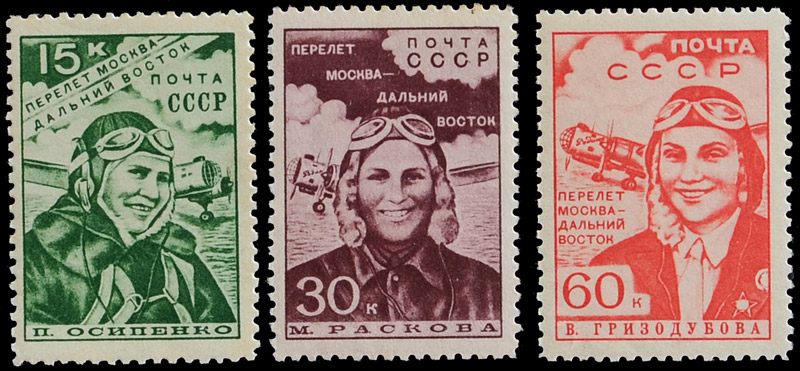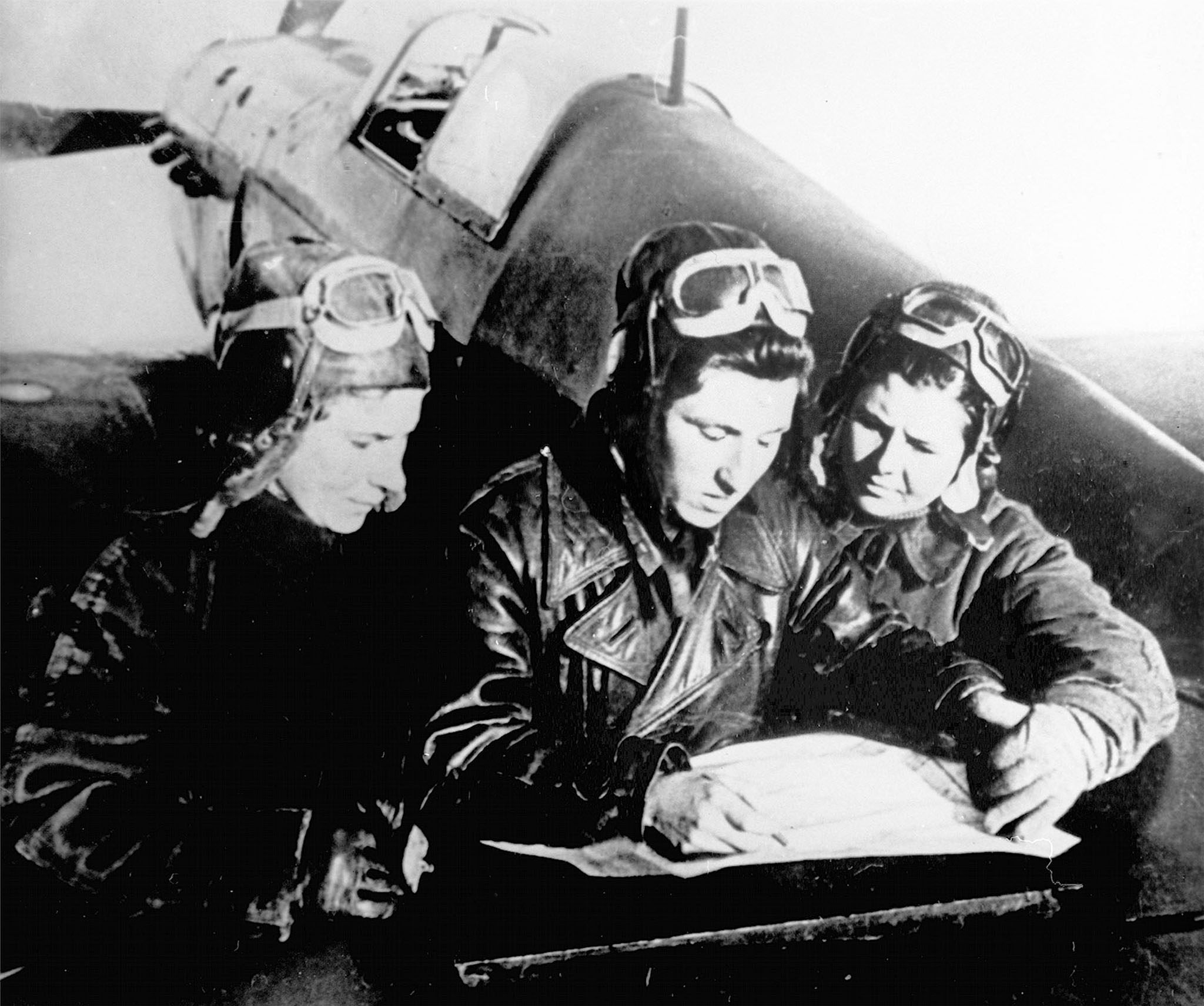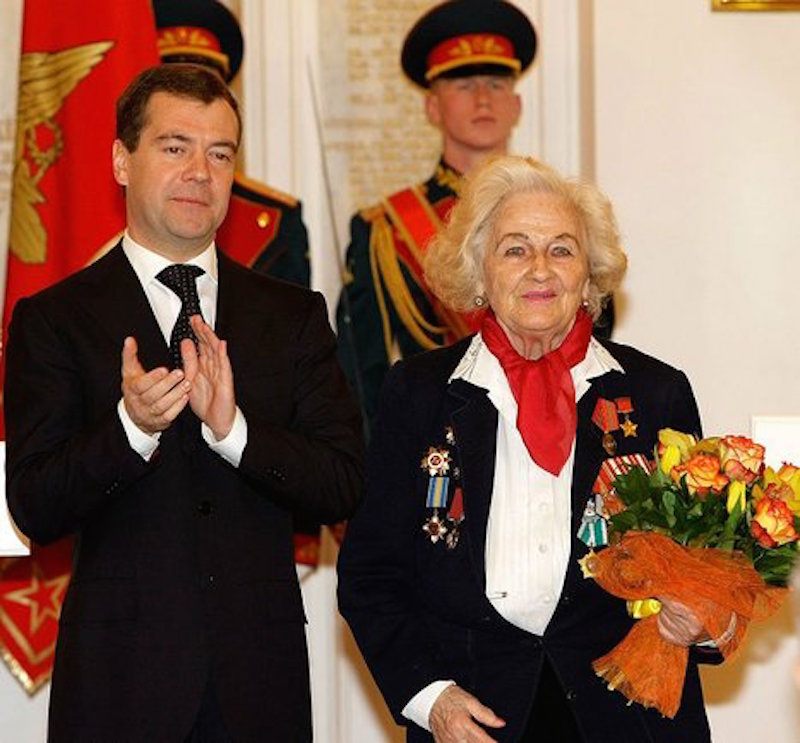Flight of the Night Witches: WWII’s All-Female Fighting Force

Night Witch commemorative stamps (Photo: toysworld.od.ua)
In the Nazi-occupied Soviet Union, German soldiers had a very real fear of witches.
Namely the Night Witches, an all-female squadron of bomber pilots who ran thousands of daring bombing raids with little more than wooden planes and the cover of night—and should be as celebrated as their male counterparts.
This month marks the 73rd anniversary of the start of their pioneering service. In June of 1941, the Axis powers pushed into the Soviet Union using the largest invading force in the history of warfare. The infamous Operation Barbarossa saw over four million troops wade into Russia from the west, establishing a line that threatened to overtake Moscow itself. The offensive was one of the most violent and terrible military actions in World War II, with countless atrocities committed against the Russian people. The battle-hardened male soldiers of the Soviet Union held the front lines against the Axis forces, keeping the invasion from overtaking the capitol.
From the start of the war, Colonel Marina Raskova, a Soviet pilot who was known as the “Russian Amelia Earhart,” began receiving letters from women across Russia wanting to join the war effort in any way they could. Many women served support roles at the time, but it was difficult to make it to the front. Raskova lobbied to finds ways for women to take a more active role in the war, and was highly successful in her efforts, leading to women being eligible for the draft and even convincing the military to establish all-female units.
In October of 1941 the order came down from Josef Stalin, that Raskova was to establish a trio of all-female air squads. The only one that remained exclusively female was the team of night bombers, the 588th Regiment, where everyone from the pilots, to the commanders, to the mechanics were women.
The regiment began filling out in 1942, with young women ranging in age from 17-26 transferring to the small town of Engels to begin flight training. The future pilots were greeted by Raskova herself with a no-nonsense, military manner. The women were issued size 42 boots, outfitted with ill-fitting military uniforms made for bulkier male soldiers. Their hair was cut short. As one of the pilots would recall in a later interview, “We didn’t recognize ourselves in the mirror—we saw boys there.”

German’s capture a downed Polikarpov Po-2 in 1941 (Photo: Bundesarchiv/Wikipedia)
The women faced significant obstacles even before they began engaging in combat—namely, with the equipment. They had to fly Polikarpov Po-2 aircraft—two-seated, open-cockpit bi-planes that were obsolete even by the standards of the day. Made of plywood frames with canvas stretched over them, the craft were light, slow, and provided absolutely no armor. The benefit of the planes was that they had a slower stall-speed than the standard German fighters, making them hard to target, and they could take off and land just about anywhere. However, this came as literal cold comfort to the aviators who had to fly the ships through walls of enemy fire in the dead of night, with the freezing wind whipping around and through the exposed cockpits, often giving the pilots frostbite.
But this did little to discourage the women of the 588th. Starting with an initial bombing run on June 8th, 1942, the all-female squadron would harry Nazi forces with overnight bombing runs all the way until the end of the war. At the peak of the regiment’s strength, it had as many as 40 two-person crews, flying multiple bombing runs as soon as the sky darkened, taking part in as many as 18 in a single night. The light planes could only carry six bombs at a time, so as soon as one run was complete the pilots would be re-armed and sent back out for another run. Of course this tightly controlled weight limit also meant the women could not bring parachutes and also had to fly at lower, more easily spotted, altitudes.
Using such vulnerable craft to make their bombing runs, the cover of night was crucial to their success and survival. Three planes would leave simultaneously, with two of the airplanes drawing searchlights and gunfire, and the third sticking to the darkness, to drop the bombs. In order to remain hidden, the pilots would also kill their engines when they got near their target, and simply glide over it, deploying their payload.

Pilots from the 586th regiment, also formed by Raskova. (L-R: Lilia Litvyak, Yekaterina Budanova, and Maria Kuznetsova). (Photo: Itar-Tass/Landov)
As the silenced bombers sailed over the Nazi forces, making a light “whooshing” sound, German soldiers began referring to them as “Nachthexen,” or “Night Witches,” a name the pilots of the 588th quickly took on with pride. Rumors began to spread among the Germans that the Soviets were giving the women pills and treatments that gave them the night vision of a cat. One of the most famous of the Night Witches, Nadezhda Popova, who herself flew 852 missions, earning her multiple medals and the title of Hero of the Soviet Union, described the situation a bit more accurately in Albert Axell’s book Greatest Russian War Stories, 1941-1945, saying, “This was nonsense, of course. What we did have were clever, educated, very talented girls.”
Unfortunately not everyone was so impressed with the 588’s fortitude and military prowess. Many in the Soviet military still found the idea of women flying in combat to be laughable, despite their clear ability. Undeterred by the lack of faith from many of their male counterparts, the women embraced their identities, and are said to have painted their lips with navigational pencils, and drawn flowers on the side of their aircraft.
By the end of the war, the Night Witches had flown somewhere in the vicinity of 30,000 bombing raids, delivering around 23,000 tons of munitions right to Nazi’s. The 588th lost 30 pilots during the fighting, but the 23 who survived, like Popova, were awarded the title of Hero of the Soviet Union. The squadron was never disbanded, but was instead converted into the 46th Guards Night Bomber Aviation Regiment, which continued to fight for the Soviet Union, although with mixed gender forces.
The Night Witches didn’t have great planes, or superior bombs, or even very much support for their unit, but they nonetheless became one of the most remarkable fighting forces of World War II. No sorcery needed.

Dmitry Medvedev honors Nadezhda Popova. (Photo: Russian Presidential Press and Information Office)
Corrections: The middle image of the members of the 586th regiment were originally incorrectly identified as members of the Night Witches. The caption has been updated to reflect their correct unit.
Its was also initially stated that women were banned from combat at the start of the war, which was incorrect, and a correction has been made to reflect that it was simply difficult to enter combat roles.














Follow us on Twitter to get the latest on the world's hidden wonders.
Like us on Facebook to get the latest on the world's hidden wonders.
Follow us on Twitter Like us on Facebook